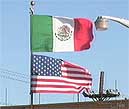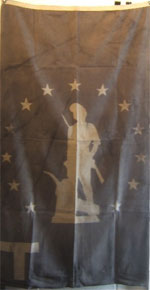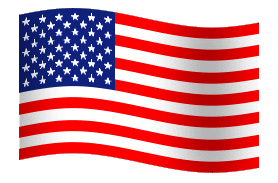
Betsy Ross and the American Flag
Please note: Our site contains the flag code in its entirety and dozens of answers to a very wide array of questions. We hope the information we have provided will be a useful resource to visitors. We are not expanding this section and cannot answer specific questions regarding the flag code and its interpretation.
Displaying the Flag
It is traditionally flown either to the right or the left of the front door. It can be on either side. When there is a choice, find a position of prominence. Sometimes that is the left of the door, sometimes the right, sometimes away from the door, but centered on the house (when you have a porch, for example). Use your best judgment to find a nice position for the flag. However, if you fly a second flag, then the US flag must be on the viewer's left of the other flag, as you approach the house.

Facing the display, from left to right: US flag, state flag, company flag. If you are flying them on two poles, place the US flag on the leftmost pole, and the state flag over the company flag on the right pole (check your state Flag Code to be sure this is acceptable). You may not fly a company flag on the same pole as the US flag.


Normally you would fly the POW/MIA flag beneath the US flag. However, if you need to fly it on its own staff, a GSA directive for federal displays states, "It is generally flown immediately below or adjacent to the flag of the United States as second in order of precedence." [Ref: Bulletin: POW/MIA Flag Display]. Military protocol states that it would follow the others.
Facing the display, from left to right: US flag, POW/MIA, state flag. If you are flying them on two poles, place the US flag over the POW/MIA flag on the leftmost pole, and the state flag on the right pole.
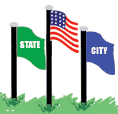

Yes. When the three poles are the same height, the priority is left to right. When the center pole is taller, then the position of prominence is the center pole, then the left, then the right.

The correct order is US, then other nationality (always flown at the same height as the US flag), and then state flag.
Section 7g of the Flag Code states: "When flags of two or more nations are displayed, they are to be flown from separate staffs of the same height. The flags should be of approximately equal size. International usage forbids the display of the flag of one nation above that of another nation in time of peace."
There are several opinions on this question. Oftentimes at marinas and yacht clubs, for example, a ship's signal mast is displayed on land. There is often discussion regarding the appropriate display of the U.S. flag. Should it match what is done at sea or should it be in compliance with the Flag Code, which does speak to displays at sea in Section 7-c? The gaff is the diagonal that projects aft from the crosstree.
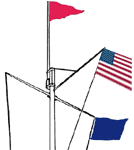
This is the convention at sea, with the U.S. flag on the gaff, with the club burgee at the peak.
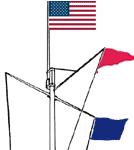
This display is consistent with the U.S. Flag Code.
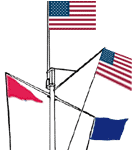
There is no prohibition against having the U.S. flag twice, and this solution is a compromise.

N.B.: You may never place two national flags on a single pole, as they must be at the same height and the approximate same size.
N.B.: You may never place a company or advertisement flag on the same pole as the US flag.
In military use, no more than two flags may be on a single pole. There is no official guideline for civilian use. The order, generally, is as follows, seen top to bottom:
- US flag
- POW/MIA
- state flags (host state first, then others in the order of admission)
- US territories (Washington DC, Puerto Rico, etc.)
- Military (Army, Marine Corps, Navy, Air Force, Coast Guard)
- other (not advertising)*
*Section 8i of the Flag Code reads:
"Advertising signs should not be fastened to a staff or halyard from which the flag is flown."
No. Corporate banners are a form of branding, and, as such, a form of advertising. Section 8i of the Flag Code reads:
"Advertising signs should not be fastened to a staff or halyard from which the flag is flown."
The Flag Code requires that the US flag be flown on federal institutions, including public schools. It does not require you to fly the US flag and it does not forbid you from displaying a foreign flag. For example, someone with Irish heritage may proudly fly an Irish flag and is not required to fly the US flag. In the early 1900s there was hostility when the German flag was flown in the US, prompting Theodore Roosevelt to state that we had one flag, and one language. We are again revisiting tensions, this time it is the Mexican flag. We understand the emotional tensions of the situation, however, the Flag Code does not support those who wish to forbid the flying of the Mexican flag within our borders without also flying the US flag.
A situation arose in Reno, where a Mexican Flag was flown above the US flag on a single pole. This was a violation of the Flag Code and was apparently done to make a political statement.
Let's start by looking at the Flag Code. You will find there is a contradiction. First it says that all foreign flags should fly at the same height as the US flag. But later, it says that no foreign flag should fly at the same height as the US flag.
7g. reads, "When flags of two or more nations are displayed, they are to be flown from separate staffs of the same height. The flags should be of approximately equal size. International usage forbids the display of the flag of one nation above that of another nation in time of peace."
7c. starts, "No other flag or pennant should be placed above or, if on the same level, to the right of the flag of the United States of America..."
7c. later on reads (emphasis ours), "No person shall display the flag of the United Nations or any other national or international flag equal, above, or in a position of superior prominence or honor to, or in place of, the flag of the United States at any place within the United States or any Territory or possession thereof..."
Notwithstanding the confusion here, it is always recommended to fly foreign flags from separate poles, and that the flags should be flown at the same height (or the US flag slightly higher) and be of same or similar size.
The challenge is which flag should be in the position of prominence. Section 7k of the Flag Code states:
When displayed from a staff in a church or public auditorium, the flag of the United States of America should hold the position of superior prominence, in advance of the audience, and in the position of honor at the clergyman's or speaker's right as he faces the audience. Any other flag so displayed should be placed on the left of the clergyman or speaker or to the right of the audience.
Does God come before country? Are secular and sacred separate spheres? In the 1840s the Nativist Riots were directed against Catholics fearing sovereignty of the Pope over the laws of the country. We advise not making a political issue over the flags. Some choose not to fly the US flag inside the church, to avoid the conflict. Most prefer to have the US flag in the church, to recognize that our Freedom of Religion is one of the extraordinary distinguishing and precious freedoms guaranteed by our Constitution.
The Christian flag may fly above the US flag only "during church services conducted by naval chaplains at sea, when the church pennant may be flown above the flag during church services for the personnel of the Navy" (Flag Code, Section 7c).
One option, to be consistent with both the US Flag Code and the Christian Flag Code, is to place the US flag at the far left (congregation's perspective) and the Christian flag to the right, front, of the congregation and outside of the communion railing. Both flags should be at the same height and of approximately the same size.
The following is the order of precedence of flags, according to Army regulations.
- The flag of the United States.
- Foreign national flags. (Normally, these are displayed in alphabetical order using the English alphabet.)
- Flag of the President of the United States of America.
- State and territorial flags. Normally, state flags are displayed in order of admittance of the State to the Union. However, they may also be displayed in alphabetical order using the English alphabet. Territorial flags are displayed after the State flags either in the order they were recognized by the United States or alphabetically.
- Military organizational flags of the Services in order of precedence
- Cadets, United States Military Academy
- Midshipmen, United States Naval Academy
- Cadets, United States Air Force Academy
- Cadets, United States Coast Guard Academy*
- Midshipmen, United States Merchant Marine Academy
- United States Army
- United States Marine Corps
- United States Navy
- United States Air Force
- United States Coast Guard*
- Army National Guard of the United States
- Army Reserve
- Marine Corps Reserve
- Naval Reserve
- Air National Guard of the United States
- Air Force Reserve
- Coast Guard Reserve*
- Other training organizations of the Army, Marine Corps, Navy, Air Force, and Coast Guard, in that order, respectively.
*During any period when the United States Coast Guard shall operate as part of the United States Navy, swap numbers 3 and 4, 9 and 10, and 16 and 17. ref
- Military organizational flags within a Service by echelon. The flag for the regimental corps will have precedence immediately before the regimental proponent's command flag. The regimental corps flag will never have precedence above a MACOM flag.
- Individual flags in order of rank. For the purpose of order of precedence, the term "individual flags" includes the Department of the Army Senior Executive Service flag.
- Other
When authorized, the following may be flown beneath the flag of the United States:*
- The Prisoner of War/Missing in Action (POW/MIA) flag
- The Army Savings Program (Minuteman Flag)
- The Retiree flag
- Commander-in-Chief's Installation Excellence Award flag
*Army Regulation 840-10 2-2.c, reads, "The flag of the United States is the only flag that may be flown from a flagpole over a CONUS Army installation unless an exception is granted by TIOH, U.S. Army. However, the Minuteman flag (AR608-15) , the Prisoner of War/Missing in Action (POW/MIA) flag, the Retiree flag, or the Commander-in-Chief's Installation Excellence Award flag, when authorized, may be flown beneath the flag of the United States without referral to TIOH for exception. The POW/MIA flag will be flown beneath the flag of the United States on Armed Forces Day, the third Saturday in May; Memorial Day, the last Monday in May; Flag Day, June 14; Independence Day, July 4; National POW/MIA Day; Veterans Day, November 11 and on occasions when the installation is hosting POW/MIA activities. The Retiree flag may be flown on Veterans Day or occasions when the installation is sponsoring activities for retirees such as open house or retiree day. Not more than one flag will be displayed below the flag of the United States and, if displayed, will be approximately 6 inches below the flag of the United States."
Source:Army Regulation 840-10 [PDF]
See What is the correct order of the flags of the Military Branches?
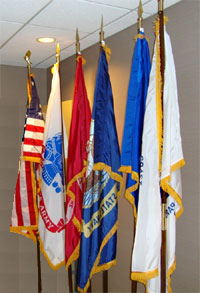
The correct order of precedence is:
- Army
- Marine Corps
- Navy
- Air Force
- Coast Guard
The US Army was established in June 14, 1775.
The US Marine Corps has had precedence over the Navy since 1921. The Marine Corps cites its origins to legislation of the Continental Congress establishing the Continental Marines on November 10, 1775.
The US Navy (until 1972) dated its establishment to legislation on March 27, 1794. Today, it dates its establishment to October 13, 1775, when George Washington, under Continental authority, took command of three privately-owned schooners to intercept British supply ships near Massachusetts.
The US Air Force became an independent service in 1947. It traces itself back to the Aeronautical Division, U.S. Signal Corps (part of the Army) in 1907.
The US Coast Guard dates itself to the founding of the Revenue Cutter Service on August 4, 1790, by Alexander Hamilton. The modern Coast Guard can be said to date to 1915, by act of Congress.
See The complete order of precedence of flags in the US
Source:Naval Historical Center
Here are the standards of the five branches of the military, in their correct order of precedence:

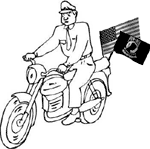
The US flag should always be on its right, as shown in this picture. The POW/MIA or other flag flies on its left, which is the viewer's right, facing the motorcycle.
When flying just the US flag or several flags, the US flag can be at the center, flying higher than the others.

The Flag Code states, "The flag should never be displayed with the union down, except as a signal of dire distress in instances of extreme danger to life or property."
The clear intent is as a call for immediate emergency assistance (danger at sea, or perhaps during a kidnapping in progress, for example).
"In times of national crisis, Americans look to the United States flag as a symbol of hope, courage, and freedom; the United States flag is universally honored; the United States flag honors the men and women of the Armed Forces who have given their life in the defense of the United States; the United States flag serves as a treasured symbol of the loss of loved ones to the countless families of those who died in defense of our Nation" (Ref: H.Res.420, sponsored by Rep. Robert Latta [R-OH])
The flag may, to some, represent just the government and its policies; but it is truly "a symbol of hope and inspiration to people at home and around the world — as a constellation which grows brighter with every achievement earned and sacrifice borne by one of our citizens." [ref]


Air Force 1 showing the regular flag on the left side and the reverse flag on the right side.
The flag decals show the union (the blue area) on the side closer to the front of the plane. On the plane's left, the decal shows the flag with the union at the left, as usual. On the plane's right side, is a "right flag" or "reversed field flag" or "reverse flag," with the union on the right. This is done so that the flag looks as if it is blowing in the wind created by the forward movement. You can see this on cars and trucks as well.
 Left Flag |  Right or "reversed field" flag |
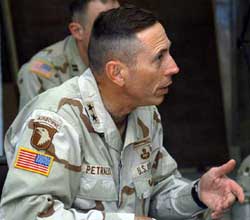
General David Petraeus
To wear our country's flag properly, the field of stars is worn closest to your heart. Further, when worn on the sleeve of a military uniform, the flag should appear to be advancing and not retreating. Thus, if your patch is to be worn on your LEFT sleeve, use a left flag (normal). For patches worn on your RIGHT sleeve, use a "right" or "reversed field" flag.
Since the Flag Rules do not specifically address the positioning of the patch, a decision is left to the discretion of the organization prescribing the wear. Some elect to use the "left" flag on both sleeves. [Note: many states and cities have ordinances pertaining to the use of the flag; you may wish to contact the Attorney General of your state or the City Attorney's office regarding this matter.] If you are planning to wear only one patch, it is recommended that you wear a "left" flag on your left sleeve.
Military guidelines specify that in support of joint or multi-national operations (as in Afghanistan), the "right" flag is worn on the right sleeve (see picture), 1/4" below the shoulder seam or 1/8" below any required unit patches. (Class A uniform excepted.)
Some people find the "right flag" disrespectful of the flag and some are calling it the "wrong flag." They seek to gain support to encourage a change in the regulations to always use a "left flag" even on a right sleeve.
Source: Army Regulation 670-1

Section 8j. of the Flag Code states, "No part of the flag should ever be used as a costume or athletic uniform."
No, the direction is not important inside a building. The US flag should be in the place of prominence in the room. This is usually at the far left corner or centered on the far wall, as you enter the room.
Yes. Section 7o reads, "When the flag is suspended across a corridor or lobby in a building with only one main entrance, it should be suspended vertically with the union of the flag to the observer's left upon entering. If the building has more than one main entrance, the flag should be suspended vertically near the center of the corridor or lobby with the union to the north, when entrances are to the east and west or to the east when entrances are to the north and south."
